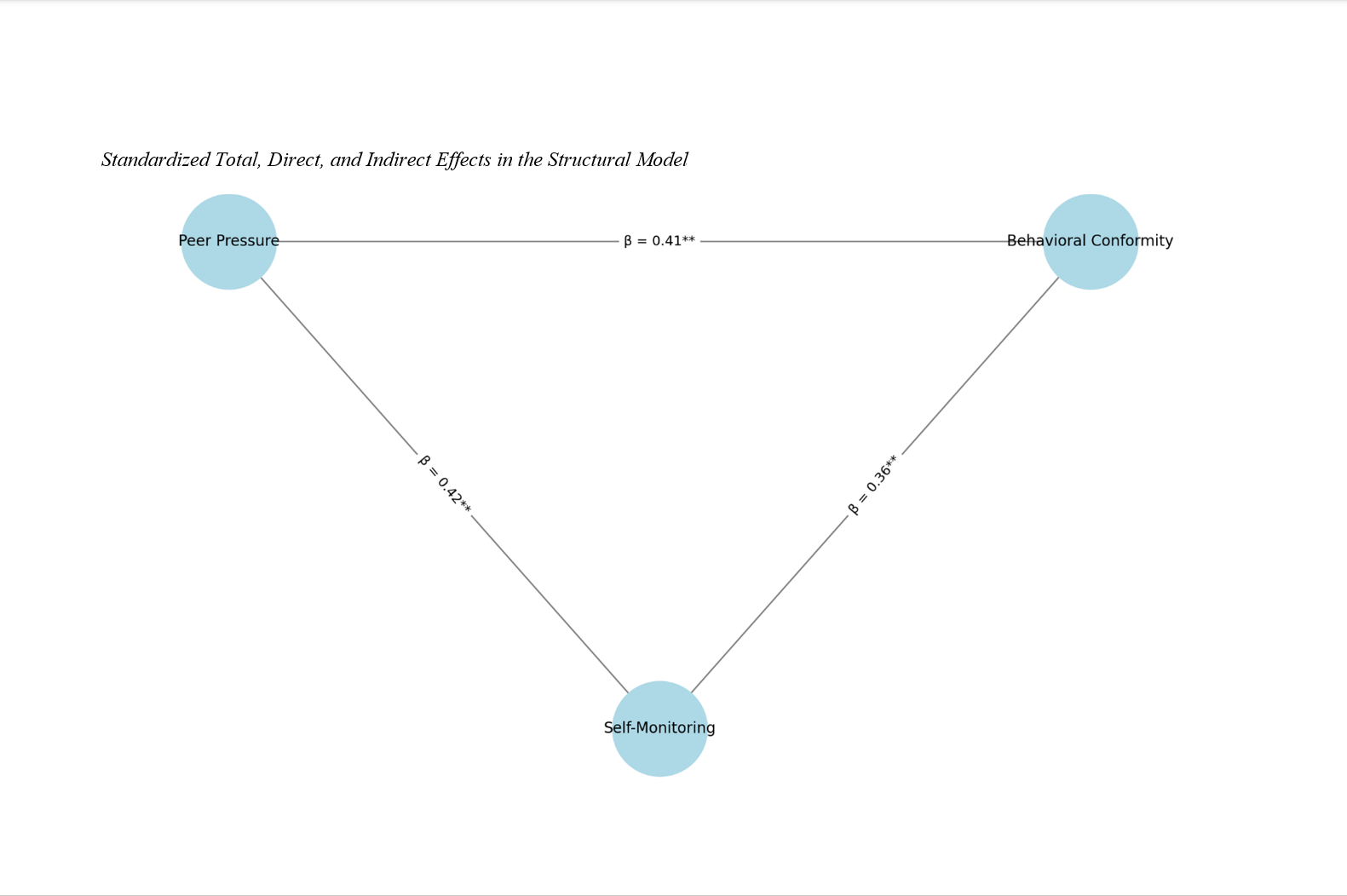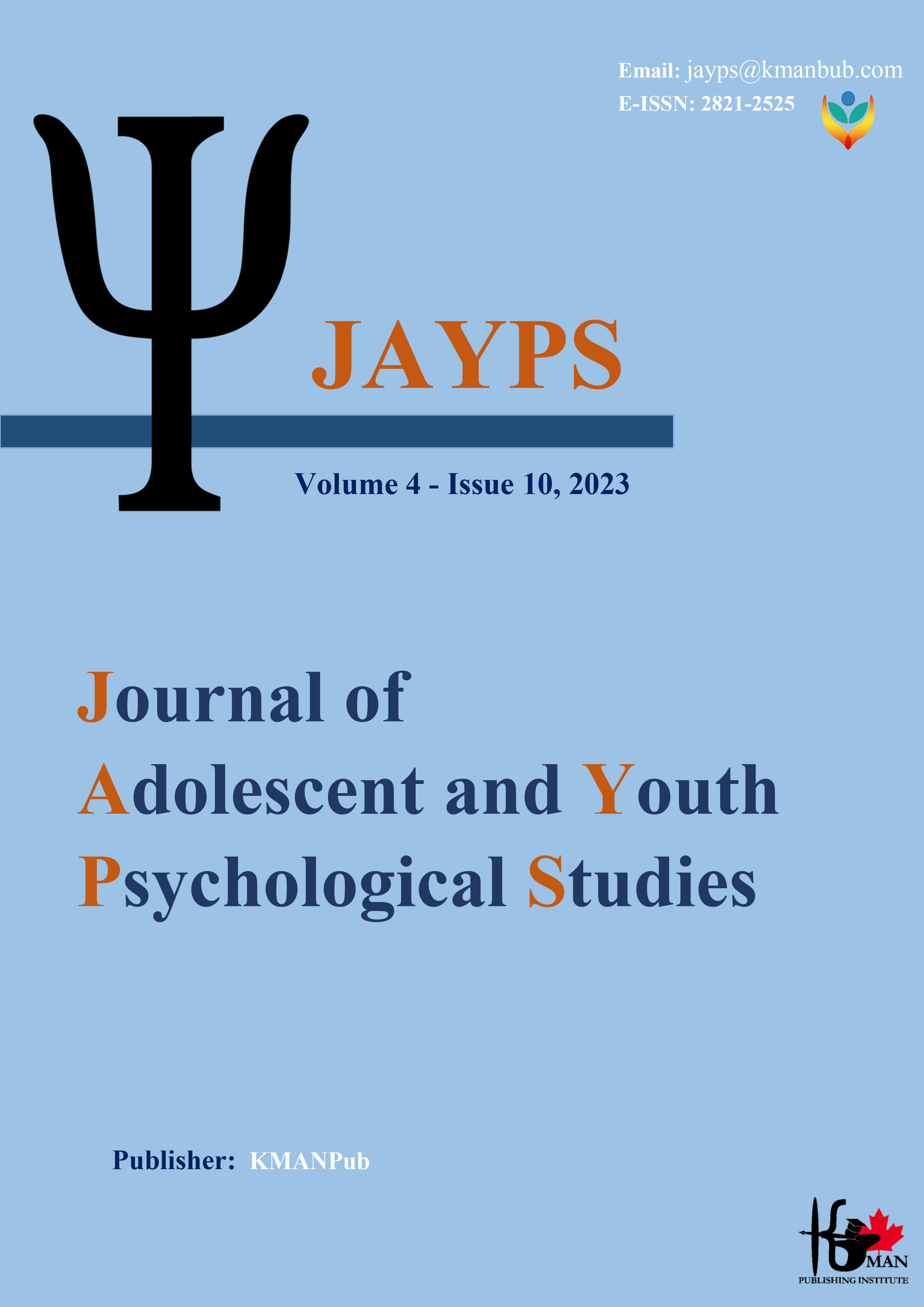Self-Monitoring as a Mediator Between Peer Pressure and Behavioral Conformity
Keywords:
Peer Pressure, Behavioral Conformity, Self-Monitoring, AdolescentsAbstract
Objective: This study aimed to investigate the mediating role of self-monitoring in the relationship between peer pressure and behavioral conformity among adolescents and young adults in India.
Methods and Materials: This research employed a descriptive correlational design with a sample of 449 participants selected based on Morgan and Krejcie’s sample size determination table. Participants, aged 16 to 25, were recruited from various educational institutions across India. Data were collected using standardized instruments: the Peer Pressure Scale, the Self-Monitoring Scale, and the Behavioral Conformity Scale. Descriptive statistics, Pearson correlation analysis, and Structural Equation Modeling (SEM) were conducted using SPSS version 27 and AMOS version 21 to evaluate the direct, indirect, and total effects among the variables and to assess the model fit.
Findings: Descriptive statistics revealed moderate levels of peer pressure (M = 28.73, SD = 6.41), self-monitoring (M = 16.58, SD = 4.83), and behavioral conformity (M = 76.42, SD = 11.09). Pearson correlation results indicated significant positive associations between peer pressure and behavioral conformity (r = .58, p < .001), peer pressure and self-monitoring (r = .42, p < .001), and self-monitoring and behavioral conformity (r = .51, p < .001). SEM analysis confirmed that the model had an acceptable fit (χ²/df = 2.28, GFI = 0.95, CFI = 0.96, RMSEA = 0.052), and demonstrated that self-monitoring partially mediated the relationship between peer pressure and behavioral conformity, with both direct (β = 0.41, p < .001) and indirect (β = 0.15, p < .001) paths being significant.
Conclusion: The findings highlight the significant influence of peer pressure on behavioral conformity and suggest that self-monitoring plays an important mediating role in this relationship. These results underscore the need to consider individual self-regulation traits when addressing peer-influenced behaviors in adolescence and early adulthood.
Downloads
References
Abomah, P. W. (2021). The Influence of Self-Esteem and Peer Pressure on Career Choice of Adolescents in Greater Accra, Ghana. Texila International Journal of Academic Research, 8(4), 86-94. https://doi.org/10.21522/tijar.2014.08.04.art010
Amara, U., Rao, S., & Siddiquii, D. B. (2023). Self-Esteem and Peer Pressure in Adolescent Males Using Drugs. Apr, 1(2). https://doi.org/10.32350/apr.12.03
B., E., & J., M. G. (2024). Friendship Circles and Self-Discovery: Peer Pressure's Impact on Adolescents' Personality and Life Satisfaction. International Journal for Multidisciplinary Research, 6(3). https://doi.org/10.36948/ijfmr.2024.v06i03.19282
B., M. P., & V., S. (2024). The Influence of Peer Pressure on Students: Cause, Effect, and Strategies for Intervention. International Journal for Multidisciplinary Research, 6(5). https://doi.org/10.36948/ijfmr.2024.v06i05.28091
Bankole, E. T., Arowosegbe, C. K., & Ajayi, O. (2021). Influence of Family Types, Peer Pressure and Parental Care on Self Esteem. American Journal of Applied Psychology, 10(6), 193. https://doi.org/10.11648/j.ajap.20211006.19
Chasapis, D., Touloupis, T., Sofos, A., Tsibidaki, A., & Lipourli, E. (2024). Non-Consensual Sexting Among Adolescents. 87-104. https://doi.org/10.4018/979-8-3693-4191-9.ch004
Deep, P. D., Ghosh, N., Gaither, C., & Rahaman, M. S. (2024). The Factors Affecting Substance Use and the Most Effective Mental Health Interventions in Adolescents and Young Adults. Psychoactives, 3(4), 461-475. https://doi.org/10.3390/psychoactives3040028
Eyiah-Bediako, S., Quansah, F., Omotosho, J. A., & Hagan, J. E. (2021). Assessment of Peer Pressure and Sexual Adventurism Among Adolescents in Ghana: The Moderating Role of Child-Rearing Practices. Social Sciences, 10(11), 418. https://doi.org/10.3390/socsci10110418
Hayek, M. A., Giannouchos, T. V., Lawley, M., & Kum, H. C. (2023). Economic Evaluation of Blood Pressure Monitoring Techniques in Patients With Hypertension. JAMA Network Open, 6(11), e2344372. https://doi.org/10.1001/jamanetworkopen.2023.44372
Herscu, O., Somer, E., Federman, A., & Soffer-Dudek, N. (2023). Mindfulness meditation and self-monitoring reduced maladaptive daydreaming symptoms: A randomized controlled trial of a brief self-guided web-based program. Journal of consulting and clinical psychology, 91(5), 285-300. https://doi.org/10.1037/ccp0000790
John, N. (2020). Relationship Between Principals’ Democratic Leadership Style and Students’ Conformity to Rules in Public Secondary Schools in Nakuru County, Kenya. Journal of Education and Learning, 2(1), 203-212. https://doi.org/10.51317/ecjces.v2i1.159
Kurade, P., & Topno, A. (2024). Associations of Peer Pressure and Self Esteem Among LGB Youth From the Metropolitan Cities of India. https://doi.org/10.14293/p2199-8442.1.sop-.pgpsl5.v1
Larsen, Y., Groß, J., & Bogner, F. X. (2020). Bringing Out-of-School Learning Into the Classroom: Self- Versus Peer-Monitoring of Learning Behaviour. Education Sciences, 10(10), 284. https://doi.org/10.3390/educsci10100284
Lim, J., & Huh, Z. (2024). Relationship Between Parental Monitoring and Cyberbullying Perpetration Among Male and Female Adolescents: Dual Sequential Mediating Effects of Self-Control and Peer Conformity of Anti-Social Behaviors. Korea University Institute of Educational Research, 91, 139-165. https://doi.org/10.24299/kier.2024.372.139
M., A. G., & Simon, S. (2024). Peer Pressure, Academic Stress and Self-Regulation Among College Students. International Journal for Multidisciplinary Research, 6(2). https://doi.org/10.36948/ijfmr.2024.v06i02.16930
Marundha, A., Herianti, E., & Anggraini, D. T. (2024). The Role of Obedience Pressure and Self-Monitoring in Public Procurement Fraud: An Experimental Analysis. Jurnal Tata Kelola Dan Akuntabilitas Keuangan Negara, 10(1), 87-103. https://doi.org/10.28986/jtaken.v10i1.1592
Motallebzadeh, K., Garmabi, H., & Fayendari, M. B. (2017). Investigating the Relationship Between Iranian EFL Teachers' Conformity to Postmethod Principles and Their Academic Success. International Journal of Applied Linguistics & English Literature, 7(1), 49. https://doi.org/10.7575/aiac.ijalel.v.7n.1p.49
Nejamis, A., Chaparro, M., Gibbons, L., Poggio, R., Moyano, D., & Irazola, V. (2023). Effectiveness of Peer Mentoring and Self-Monitoring to Improve Blood Pressure Control in a Vulnerable Population in Argentina: Pragmatic Randomized Open-Label Controlled Trial. Chronic Illness, 20(4), 684-698. https://doi.org/10.1177/17423953231187170
Ogelman, H. G., & Kahvecİ, D. (2024). Coping With Peer Pressure and Social Emotional Well-Being in Preschool Children. International Journal of Educational Spectrum, 6(2), 191-203. https://doi.org/10.47806/ijesacademic.1409535
Paciello, M., Corbelli, G., Pomponio, I. D., & Cerniglia, L. (2023). Protective Role of Self-Regulatory Efficacy: A Moderated Mediation Model on the Influence of Impulsivity on Cyberbullying Through Moral Disengagement. Children, 10(2), 219. https://doi.org/10.3390/children10020219
Radetić-Paić, M., Kadum, S., & Kopas-Vukašinović, E. (2022). Susceptibility to Peer Pressure – Self-Assessment of Students of Primary School and Preschool Education. Revista Romaneasca pentru Educatie Multidimensionala, 14(2), 01-18. https://doi.org/10.18662/rrem/14.2/564
Ray, J. V., & Park, H.-M. (2024). The Influence of Parenting on Delinquency: The Mediating Role of Peers and the Moderating Role of Self-Control. Criminal Justice and Behavior, 51(6), 876-895. https://doi.org/10.1177/00938548241229678
Sattar, A., & Malik, D. S. (2021). Peer Pressure as Predictor of Delinquent Behavior. The Mind-Journal of Psychology, 1(1), 1-9. https://doi.org/10.36755/tmjp.v1i1.4
Sultana, I., Ditta, A. A., & Atta, A. (2024). Influence of Family Dynamics and Peer Pressure on Academic Performance: The Mediating Role of Self-Esteem in Pakistan. 3(3), 12-23. https://doi.org/10.61503/cissmp.v3i3.178
Xu, X.-P., Han, W., & Liu, Q. (2023). Peer Pressure and Adolescent Mobile Social Media Addiction: Moderation Analysis of Self-Esteem and Self-Concept Clarity. Frontiers in Public Health, 11. https://doi.org/10.3389/fpubh.2023.1115661
Yang, J., Li, W., Dong, W., Gao, L., & Wang, X. (2023). The Moderating Roles of Peer Pressure and Family Economic Stress in the Longitudinal Links Between Adolescent Trait Anger and Cyberbullying Perpetration. School Psychology, 38(2), 79-87. https://doi.org/10.1037/spq0000514

Downloads
Additional Files
Published
Submitted
Revised
Accepted
Issue
Section
License

This work is licensed under a Creative Commons Attribution-NonCommercial 4.0 International License.








